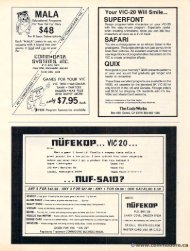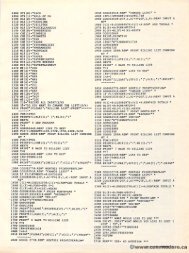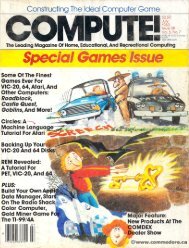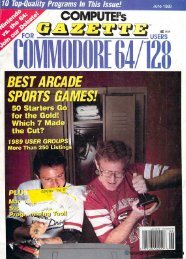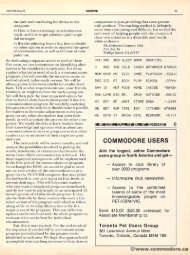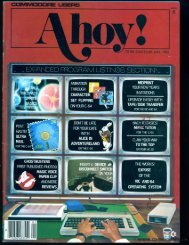May June 1980 - Commodore Computers
May June 1980 - Commodore Computers
May June 1980 - Commodore Computers
Create successful ePaper yourself
Turn your PDF publications into a flip-book with our unique Google optimized e-Paper software.
MAY/JUNE. <strong>1980</strong> I960 ISSUE 4 COMPUTE. 73<br />
A class consists of about fifteen en students per com<br />
m~<br />
puter (our collaborating schools have only one APPLE<br />
each; ; we hope to try the curriculum in multi<br />
l11ulti~<br />
computer classes later.) Five groups of three students<br />
alternate computer pUler use with planning work using graph<br />
paper and marker pens. The off-linee students are<br />
planning their strategies, doing hand-simulations,<br />
hand~ ations,<br />
and observing the online students; for to graduate-<br />
to the next activity, a group must successfullyy<br />
predict the outcome of an assigned "seed" (geo<br />
metricc pattern, algorithm, , program, etc.) The<br />
activities develop during eighteen een weeks, from a non<br />
nonlinguistic<br />
color-pattern process called "quilting"<br />
through immediate-mode i a t e ~m and straight-line-codes a i c~code emry<br />
entry<br />
of TURTLEGRAPHICS (Papert, 1970) commands,<br />
the introduction of PASCAL control structures such<br />
as REPEAT. .... .UNTIL and IF. . . ..THEN, , 10 to the<br />
creation of cartoon characters and their animation<br />
with complex programs using the RASCALR animation<br />
system. The output is always color graphics aand music;<br />
the curriculum um steadilyy increases its ""interactivity"<br />
as students learn how to use joystick input to control<br />
various types of motion. There is always an under~<br />
lying g lesson about how programs work. All code is<br />
in a completely structured language (PASCAL),<br />
and is taught" "from the insidc inside OUl out" J) -~<br />
only at<br />
later stages do "environmental details" such as<br />
declarations become of concern. A PASCAL interi<br />
nl er~<br />
preter r is used which scrolls the source-program being<br />
executcd executed on the bottom of the screen (at a con<br />
trollable rate) while thee program produces its output<br />
on the e top part of the screen. A working system<br />
will be on exhibit at NECC/80. NECC/SO.<br />
The cognitive style of the HSCS Curriculum<br />
The central common fact that unifies our program/<br />
lessons Quilting, Turtlegraphics Turtlcgraphics and more traditional<br />
interactive games is that they sell themselves. No one<br />
has to compel students to do their assignments.<br />
The point at which our curriculum diverges<br />
from ""closed" games is in the fact that the e only<br />
real oopponent in traditional games is a pseudo pscudorandom<br />
number generator, r , orr perhaps another<br />
human. In a cognitive game the opponent is the thc<br />
rich structure of our own ignorance.<br />
. . The<br />
excitement ent of being able to create pattern and<br />
order is as old as the wall-paintings in the caves<br />
of France. It is an essentially y human activity, onc one<br />
at which all players can win. It is also a ''meta-<br />
game', , in which an infinite number of specific<br />
games and traditional games is analogous to that<br />
between a set of blocks and a preassemblcd lOy. toy.<br />
meta<br />
A different order of learning becomes possible.<br />
.<br />
The design style of the HSCS Curriculum<br />
The fundamental design principle we have<br />
followed owed is to attempt to make each lesson augment<br />
the student's skillss in three areas: discovery,<br />
control, aand design. We e allow students to "play"<br />
with the system as each new feature is introduced,<br />
but they have ""discovery questions" whose answers<br />
they seek as they ""mess around", in more orr less<br />
structured ways. They need to find thee answers to<br />
be allowed access to thee next level of the system.<br />
Studellls Students develop discovery skills by experimentally<br />
answering questions like "what docs this command<br />
do?"<br />
We e ask students to undertake a specific<br />
"challenge", such as the ""shoot-the-dot" game,<br />
to develop their ability 10 to control the computer<br />
by selectingg the correct command and providing<br />
correct values for its operands. Their understanding<br />
g<br />
of the system is built by simulation exercises,<br />
which allow them to predict the behavior of a<br />
command, thus to choose the right command.<br />
Later in the semester, students will begin<br />
writing g programs; but even at earlyy stages there is<br />
the impetus to design input sequences to produce<br />
thee desired pattern. . Students must be able to produce<br />
a sequence of commands which produces the<br />
predicted output on first submission, n , to graduate<br />
to the next t level of the system. .<br />
AnOther Another principle e we have followed can be<br />
summed up in the phrase' "design 'design from the first<br />
experience". We believe that computer science<br />
(orr anything else) should be taught ""from the inside<br />
out". That is, first t experienccs experiences must incorporate<br />
the heart hean of thee mailer matter at hand, with as little<br />
extraneous matter as possible. For instance,<br />
nce,<br />
quilting teaches the fundamental core of the<br />
computing experience: : in repetition of a controlled<br />
process, there is great power. The Quilting lesson<br />
is taught without introducing a word of jargon, j previous assignments, or complex command<br />
sequences. Quilting, and its fundamental message,<br />
can be taught to illiterates. iterates. The second lesson<br />
similarlyy teaches thee relationship between opcrands,<br />
operands,<br />
operators and results. Only y after students have firm<br />
operational skill with a given tool, , do we introduce<br />
terminology, written reference materials and the<br />
ultimately necessary environmental details such as<br />
data declarations and control statements. We are<br />
excited by the prospect of transforming rming gaming, a<br />
traditional problem area for computing tcachers, teachers, into<br />
one of their primary tools.<br />
The authors acknowledge and appreciate the e assistance of their<br />
collaborators: aboralOrs; R. R . M. Aiken, C. E. Hughes, H C. C:. R R. . Gregory<br />
and J. A. Ross (Universit), (University of Tennessee); I.. L. Demarotta Dcmarotta<br />
((H. I-I. C. Ma)'llard <strong>May</strong>nard High School); E. Miner (Alcoa High School).<br />
References<br />
Aiken, R R. . M.; Hughes, C. E.; and Moshell.J. , .1 . M.,<br />
"Computer Science Curriculum For High School Students",<br />
Sludents",<br />
Proceedings ACM/SIGCSE Conrerence, Conference, Kansas Kallsas City, Montana,<br />
February 25, <strong>1980</strong><br />
Moshell.J. , M M. . and Hughes, C. E. ""'RASCAL: Microcomputer<br />
canaan cartoon animation with PASCAL", Proceedings ACM/ ACMI<br />
SIGGRAPH Conference. Conference, Seattle, Washington, , August <strong>1980</strong><br />
Papen. Papert, S., ""Teaching Children n Thinking", Proceedings<br />
IFIP VYorld World Congress all on Complil <strong>Computers</strong> and Education, , Amslt!I"dam Amsterdam, ,<br />
1970.<br />
Postman, Neil, ""The Firs! First Curriculum: um: Comparing School<br />
and Television", Phi Delta Kappan, , 61:3, November 1979.<br />
This work is partially pania )' suppon supported cd by NSF Grant SED-79-18991 1 ©



